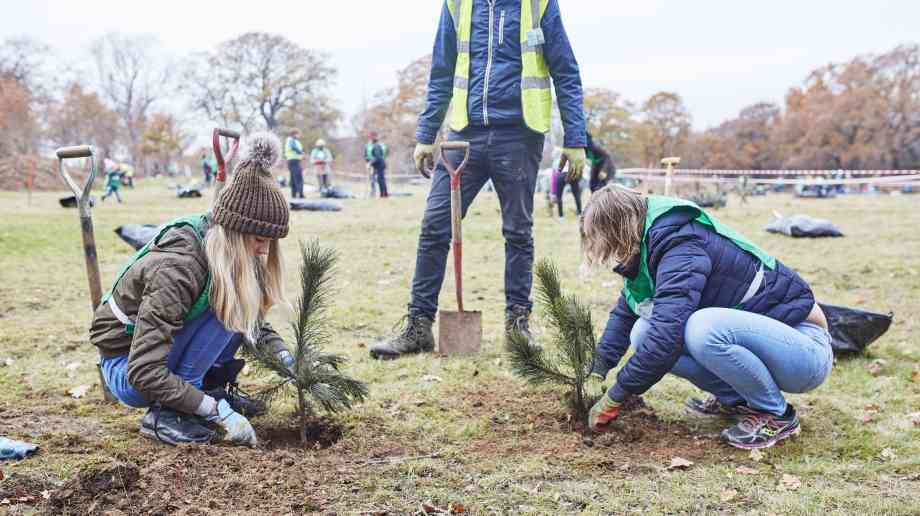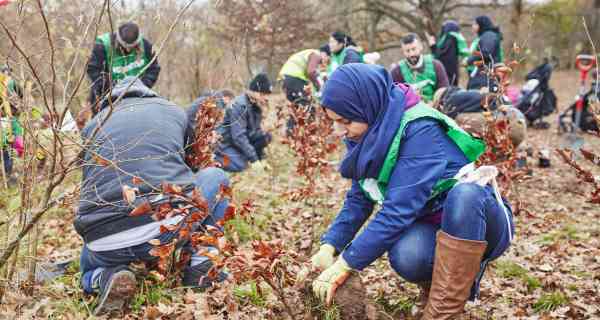Sue Robb of 4Children talks to Julie Laughton and Alison Britton from the Department for Education about the role of childminders in delivering the 30 hours free entitlement.

Trees – a vital link in urban stormwater management
Suzanne Simmons, projects director for Trees for Cities, talks about flood risk management and how this can be achieved through the charity’s urban tree planting and Edible Playgrounds programmes
Trees for Cities is the only UK charity working at a national and international scale to improve lives through the creation of greener cities. We do this by working alongside partner organisations, local authorities and volunteers. Our success comes from revitalising forgotten spaces, creating healthier environments and growing food with kids.
The name Trees for Cities demonstrates a singular focus, when in fact the planting of trees rarely happens in isolation, especially the way we do it. We consult communities on our project designs and engage them in tree planting. We are currently focusing on clustering site selection through strategic partnerships with London Boroughs including Ealing, Redbridge and Lambeth. It is with these partner organisations and others that we are able to consider how our projects and our match funding can slot into local and regional ambitions for green infrastructure networks and catchments.
Cities across the UK are rightly focusing on mitigating the impacts of poor quality air and as a result Trees for Cities is able to tap into funding that promotes increased tree cover and green screens. In addition, and more importantly, there are comprehensive approaches being considered to mitigate against the multiple impacts of climate change and the unpredictable weather patterns we are presently witnessing. A key area is mitigation against the impact of surface water flooding and linking projects in to the objectives of local flood risk management strategies. Localised flooding can often be due to ageing below ground sewer infrastructure where combined sewer overflows can spill a heady mix of foul and surface water into urban rivers as a consequence of short intense periods of heavy rainfall. Inadequate capacity below ground can leave a back-up of surface water that is unable to enter the sewerage system quickly enough.
The Environment Agency’s best estimate of the economic cost of the winter floods 2015 to 2016 in England was £1.6 billion with approximately £73 million of that cost hitting local authorities. It makes sense to consider how to mitigate against this in the most effective, efficient and, where feasible, simplest ways possible. Where previously it has been a reactive response to very local or catchment flood events, increasingly the steer for improved national and local infrastructure is emerging from top down.
The National Infrastructure Assessment for the UK made recommendations in July 2018 on the country’s identified infrastructure needs and priorities. The government will now have to formally respond. The Assessment includes a range of recommendations, including ‘the government should put in place a long-term strategy to deliver a nationwide standard of flood resilience by 2050 with funding for flood risk management increasing significantly over the coming decades’; and ‘these plans should evaluate the full range of options including traditional flood defences, ‘green infrastructure’ (whether natural flood management or sustainable drainage systems), individual property measures and spatial planning’.
Natural flood management
Meanwhile the government’s 25 year Environment Plan (25YEP) supports many of Trees for Cities’ objectives and provides hooks for local planning authorities to embed green infrastructure in their local planning policies. The 25YEP focuses on natural flood management solutions; an industry-led voluntary code of practice on flood risk planned for this year; a goal to plant one million trees in England's towns and cities by 2022; supports a new Northern Forest; a national Tree Champion has been appointed; a new woodland creation grant scheme will be introduced; and a Tree Health Resilience Plan is scheduled.
The revised National Planning Policy Framework (NPPF), released in July 2018, further strengthens the case for sustainable drainage systems (SuDS) and natural flood management, placing emphasis on local authorities to consult with lead local flood authorities in areas of flood risk. Strengthening the need for SuDS is welcome, especially where the enactment of Schedule 3 of the Flood and Water Management Act (2010) is not in place. However, it only applies to larger developments. It may not capture a multitude of smaller developments and the definition of exemptions will be almost certainly be challenged. Essentially the power to use low cost effective solutions that provide multiple benefits can be delivered through local planning policy and be supported by governmental steer even if not fully embedded in legislation. The onus however will be on local authorities to consider how best to incorporate these plans through limited resources and into policy. Creating policy will be essential but enforcing new policies will require additional time and finances from already stretched sources. With £36 million allocated by the government in March 2018 for flood defences across England it will be interesting to see how this balances out when spent across hard grey infrastructure into the softer green/blue solutions; how costs for hard and expensive interventions compare to costs that deliver effective green-blue interventions, and how that equates to value for money and public expenditure.
It may be worth local planning authorities and those making strategic decisions using more simple and visible green infrastructure, solutions such as SuDS, to mitigate against localised surface water flooding; or the provision of temporary or permanently well designed space in places where surface water is likely to exceed existing drainage systems. Trees for Cities uses a partnership approach to deliver projects by bringing match funding and a long term connection to capacity building for future maintenance and monitoring of sites. These relationships can bring sustainable high value results locally.
Trees for Cities is more often included in developing retrofit solutions for individual open spaces that may have been sealed by non-porous paving such as school playgrounds and carparks; or on open spaces managed as close mown amenity grassland, a maintenance approach that offers low level benefits to the environment. In cracking open these sealed-in surfaces and loosening the soil of bland grasslands, Trees for Cities aims to generate a greater range of benefits and improve the functionality of the open spaces we work on. These may be rain gardens created by disconnecting the down pipes of buildings, to provide educational resources on the water cycle, and how to make Edible Playgrounds thrive, or fruit orchards and community forests in under-utilised green spaces; or street trees along heavily polluted highways. In taking this approach, the value of water can be appreciated as a resource and not a waste product.
For example a study in Salford backed by the Environment Agency, City of Trees, Salford City Council, Urban Vision, United Utilities and monitored by University of Manchester, is currently assessing the ability of street trees planted in especially designed trenches to reduce the amount of water entering sewers during periods of heavy rainfall. They have recently reported how just three London Plane trees have retained up to 78 per cent of surface water runoff from adjacent highways and delayed the remainder by up to three hours before reaching the existing below ground drainage system.

Evidence to support the approach of making landscapes work harder
They become more productive, more biodiverse and offer greater resilience to flooding. This can be through incorporation of water retention components such as swales, basins and ponds on the surface. Projects can all contribute to water quality improvement by creating greater scope for infiltration, slowing the flow of surface water and removing suspended pollutants before they enter urban water courses. Whilst a single rain garden and tree pit may have limited impact, collectively and in larger numbers within a catchment area, they can support flood risk management agendas at local level. The mass planting of urban trees and woodlands can collectively have a significant and increasing benefits as the trees grow and mature. This will be evidenced over time when Trees For Cities completes the first mass tree planting event in London with the Greater London Authority (GLA) in December 2018.
In many respects the work that Trees for Cities has been doing for the past 25 years has proven a successful model because of its simplicity and transparency, and because the outputs are replicable, interactive, visible, aesthetic and provide multiple benefits to communities in greatest need. Most importantly the planting of trees provides a lasting legacy to communities that continues to increase with each decade when the right species is used in the right location.
Company Focus
Just Lanyards is a subsidiary name of Gifts 2 Impress Limited, who have been trading for over 25 years, we therefore pride ourselves in having endless experience covering all aspects of the promotional merchandise industry.
Event Diary
UKREiiF has quickly become a must-attend in the industry calendar for Government departments and local authorities.
The multi-award-winning UK Construction Week (UKCW), is the UK’s biggest trade event for the built environment that connects the whole supply chain to be the catalyst for growth and positive change in the industry.
Supplier Profiles
Geo Energy
At GeoEnergy Design, we're on a mission to disrupt the traditional way heating and cooling ha
Latest Features
Professor Harith Alani, director of the Knowledge Management Institute at the Open University explains how AI can be used for good and bad.
Alex Lawrence, head of health & social care, techUK sets out techUK’s Five Point Plan for CareTech.












